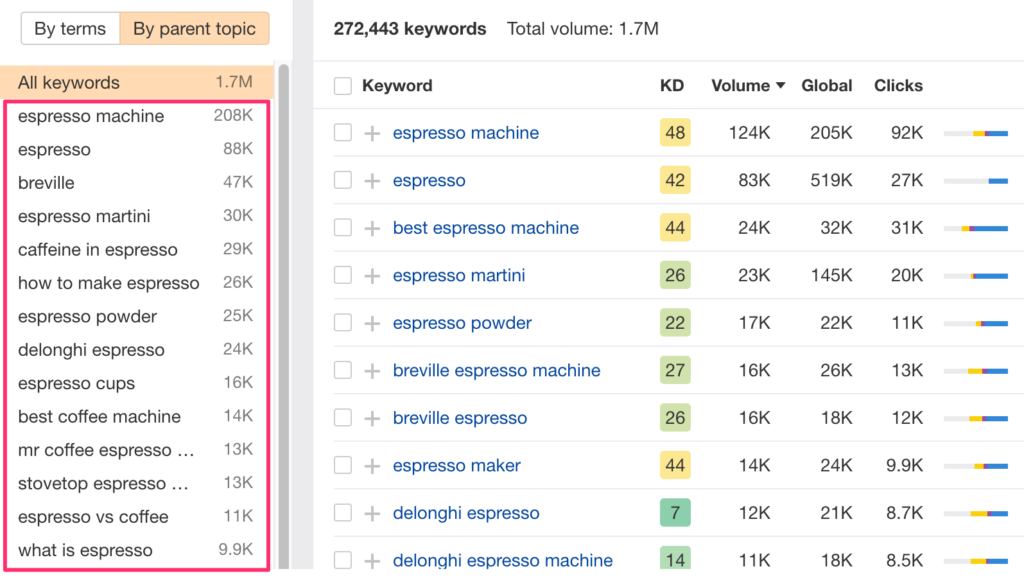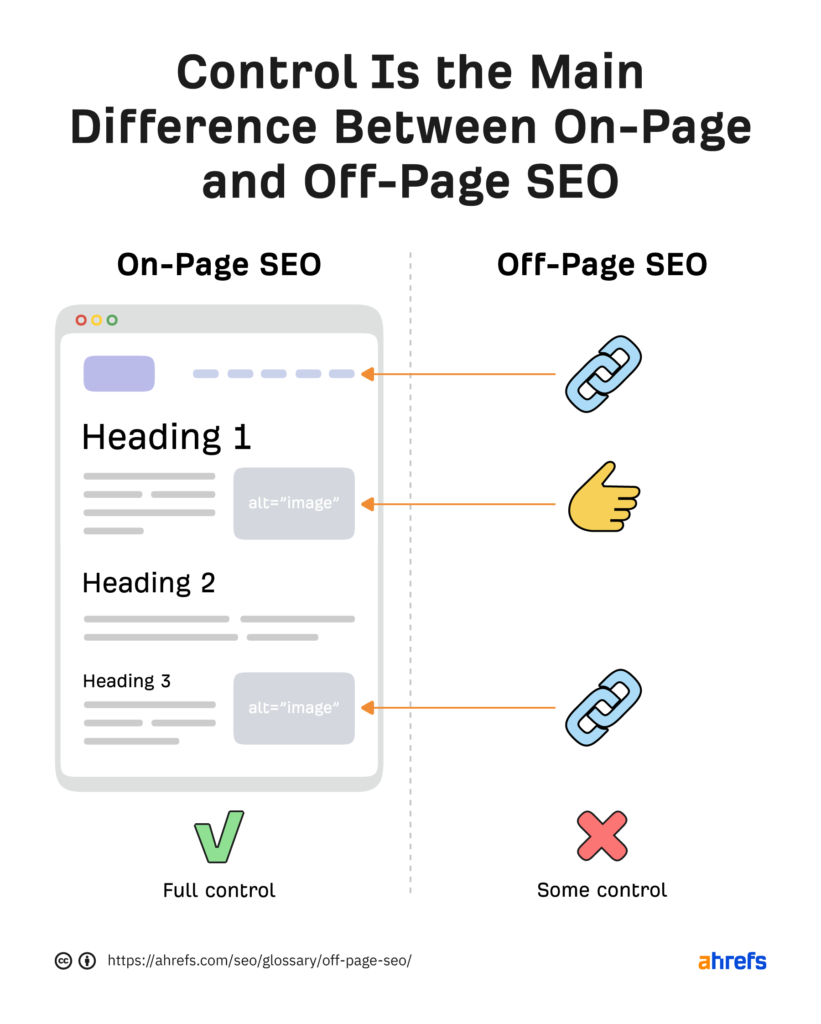SEO Best Practices – The Ultimate Guide
Let's start at the very beginning, shall we? SEO, or search engine optimisation, makes your website more visible and findable on search engines like Google, Bing, and Yahoo. Why's that important, you ask? Imagine you've just opened a shiny new shop on the high street. You've got the best products, the friendliest staff, and a storefront that'd make Mary Portas jealous. But if no one can find you or even knows you exist, how will you get customers through the door?
That's where SEO comes in. It's like putting up great, flashing neon signs pointing people directly to your brilliant website. The better your SEO, the higher your rank in those search results and the more likely people are to stumble across your online home. In our digital age, a solid SEO strategy has become essential for any business wanting to stay ahead of the curve.
Table of Contents
On-Page SEO Checklist

Keyword Research
Keywords are the foundation of any solid SEO strategy. They're the words and phrases people type into Google when searching for stuff. The goal is to find the right keywords – the ones your potential customers are searching for. Then, you optimise your website and content around those terms.
Finding Keywords
There are a bunch of keyword research tools that can help. My top picks:
- Google Keyword Planner (free if you run Google Ads)
- SEMrush
- Ahrefs
- Moz Keyword Explorer
These let you see search volumes for keywords along with other funky metrics. The data will clue you into which ones to target.
Focus on keywords with decent monthly search volume but not crazy high competition. Long-tail keywords (longer, more specific phrases) are sweet spots – good volume, lower competition.
Clustering Keywords
Once you've ID'd some good target terms, cluster them into logical topics. Say you run a plumbing website. Keywords like “leaky faucet repair”, “toilet installation”, and “fix clogged drain” could cluster under “Plumbing Services”.
Clustering helps you map out content for different sections of your site. It makes the structure more intuitive for visitors (and search engines).
Example Keyword Cluster:
Plumbing Services
- Leaky faucet repair
- Toilet installation
- Fix clogged drain
- Unclog sink
- Shower repair
Home Emergencies
- Emergency plumber near me
- Emergency plumbing repair
- Burst pipe fix
- Flooded basement
Bathroom Remodeling
- Bathroom remodel cost
- Bathroom renovation ideas
- Best bathtubs 2024
- Walk-in shower installation
On-Page Optimisation
On-page refers to optimising the content on your web pages. Doing it properly tells Google what each page is about so it can rank you for the right keywords.
Title Tags and Meta Descriptions
The title tag and meta description don't directly impact rankings. But they're mega vital as they show up in search results. The title appears as a clickable headline. The meta desc is the little snippet of text below.
Optimise these:
- Include your target keyword naturally in the title
- Use a compelling title to increase CTR (click-through rate)
- Keep meta desc snappy – 155 chars max
- Summarise what the page is about in the meta
- Use relevant keywords but make it readable
A high CTR boosts rankings indirectly. If people keep clicking your result, Google sees it as relevant and authoritative.
Headings and Body Content
The headers and body copy on the page itself matter even more. Make sure to:
- Use H1, H2, H3, etc tags in a logical hierarchy
- Include your target keyword in the H1 header
- Sprinkle related keywords throughout headers and body
- Write long-form content (aim for 1500+ words)
- Use visuals like images, charts, and videos
- Optimise images with descriptive alt text
Write for humans first. Stuffing your content full of keywords is a no-no these days. Focus on addressing the searcher's intent. Answer their questions in-depth.
URL Structure
The URL (web address) of each page impacts SEO, too. Use descriptive, keyword-rich URLs so Google knows what each page is about.
For example:
- Good: www.plumbingco.com/bathroom-remodel-cost
- Bad: www.plumbingco.com/page27
Use hyphens to separate words in the URL. Avoid underscores, unnecessary parameters, and excessive folders.
Site Architecture

Speaking of being intuitive, your site needs to be laid out like a good old London A-Z. Clear navigational structure, quick loading times, and a logical hierarchy of pages all play a part in keeping visitors engaged, and search engines appeased.
XML Sitemaps
While discussing on-site structure, XML sitemaps are a godsend if you want all your pages to be easily discovered and indexed. They act like a virtual map for search engine crawlers, helping them efficiently navigate even the most sprawling sites. Chuck one of those bad boys into your Google Search Console, and you're already on the path to glory.
Technical On-Page:
- Robots.txt file
- Canonical tags to avoid duplicate content
- Rel=Nofollow links for sponsor or paid links
- Compression (Gzip, Brotli) to reduce page weight
- Mobile-friendliness for our on-the-go society
- Secure Socket Layer (SSL) adds that tasty little padlock
Once you've ticked those techy to-dos off your list, you're well on your way to a website that users and search engines will adore.
Content Marketing
Content marketing is the process of consistently publishing high-quality educational content. It positions you as an authority and drives relevant traffic, links, and conversions.
An effective content strategy includes:
- Blogging consistently (at least weekly)
- Understanding and solving reader pain points
- Promoting content heavily (amplification)
- Repurposing into various formats (video, podcasts, etc)
- Building an email list to nurture leads
It's a long game. But keep at it; the compounding benefits are massive. I promise!
Off-Page SEO

On-page SEO is vital, but it's not the whole picture. To skyrocket those SERPs (Search Engine Results Pages), you must also get your ducks in a row off the page.
Link Building
Links from other websites (backlinks) tell Google your site is trustworthy and authoritative. Generally, the more high-quality backlinks you have, the higher your rank.
Natural links earned through great content and outreach are best. Avoid sketchy tactics like paid links or comment spam. Google can easily detect unnatural link-building.
Creating Linkable Content
To earn backlinks organically, you'll need something worth linking to. Focus on creating high-quality, unique content:
- In-depth ultimate guides
- Well-researched case studies
- Original research and data studies
- Tools, calculators, and other resources
- Comprehensive “how to” tutorials
Post it on your blog and promote the heck out of it. Answer questions on forums, reach out to influencers, and tap existing contacts. The more eyes on your epic stuff, the more links will roll in.
Tracking Backlinks
It's helpful to monitor your backlinks. Both to analyse where referrals come from and spot unnatural links you may want to disavow.
Use a Monitor Backlinks tool to easily track all referring domains and anchor text.
Social Signals
While the exact influence social shares and engagement have on SEO is up for debate, it certainly doesn't hurt to get your audience sharing and Retweeting the heck out of your posts. Social signals show search engines that people find your stuff useful and engaging enough to start conversations around it. Plus, even a small social following means more traffic to your site.
Online PR & Outreach
Getting mentions, features and backlinks in high-profile online publications, blogs, and communities is like injecting your website with pure SEO juice. Sites seen as authoritative, trustworthy and valued by their readers can pass that good reputation onto you via a tasty backlink. And with some creative outreach and story pitches to the right people, that could be your site reaping those rewards.
Technical Off-Site:
- Track 404s and broken links regularly to address errors
- Check your site's crawl errors via the Search Console
- Monitor site uptime and page speed via webmaster tools
- Use SEO rank tracking tools to keep an eye on progress
- Get those SSL, canonical and robots.txt issues sorted pronto
Phew, that's a lot of off-page factors to bear in mind! But with some careful planning and consistent effort, you can make sure search engines see your website as popular and dependable as a cosy Irish pub.
Local SEO Fundamentals

Local SEO should be high on your agenda if you're a business with a physical presence, like a shop or restaurant. You want people in the local area to find you when they search for your services nearby.
Google My Business
First things first, set up a comprehensive Google My Business account. This gives you a handy dashboard to monitor reviews, post updates, and fine-tune how your business appears on Google Maps and local search. It's a complete no-brainer.
Local Listings & Citations
- Get listed on leading data aggregators (Yell, Yelp, TripAdvisor, etc)
- Build consistent citations across local directories and sites
- Chamber of Commerce, local council business listings, etc
- Encourage customers to leave reviews on Google and other sites
The more accurate, consistent citations you build up across the internet, the more authoritative your NAP (name, address, phone number) will seem to search engines.
NAP Consistency
NAP stands for Name, Address, and Phone Number. These core details about your business need to be consistent everywhere online. Consistency builds authority and trust.
A few key places to ensure NAP accuracy:
- Google Business Profile
- Citations on local directories
- Website header/footer
- Social media profiles
Local Keywords
In addition to service keywords, target local search terms. Things like:
- [Service] in [City]
- [Neighborhood] + [Service]
- Near me
- “Plumbers near Manchester”
- “Bathroom remodel Birmingham”
Optimise each page or location page accordingly. Mention the local area several times in headers, body copy, alt text, etc.
Google Business Profile
An up-to-date, fully fleshed-out Google Business Profile (GBP) is crucial for ranking in Maps and local finders. Optimise:
- Categories
- Service areas
- Opening hours
- Images
- Description
- Posts (for timely specials and updates)
Technical SEO: The Nuts & Bolts

Technical optimisation makes it easy for search engine bots to crawl, understand, and index your website. It lays the strong foundation required for great rankings.
Site Speed
Site speed (or page speed) refers to how fast your pages load. The quicker, the better in terms of SEO.
A bunch of factors impact site speed:
- Web hosting provider
- Use of page caching
- Image optimisation
- Lean code (avoid bloat)
- Content delivery network
- And more
Use tools like PageSpeed Insights and GTMetrix to analyse your site. Fix any speed issues that crop up! A slow site leads to high bounce rates and poor rankings.
Mobile-Friendliness
Today, over half of all web traffic comes from mobile devices. So, a mobile-friendly site (also called mobile responsiveness) is necessary.
Google ranks sites based on their mobile versions by default these days. You'll get penalised if your pages aren't optimised for smaller screens.
Common elements of a mobile-optimized site:
- Fast-loading pages (speed is critical on mobile)
- Responsive or mobile-friendly design
- Readable text without zooming
- Spacing for tap targets
- No unplayable content or pop-ups
Test and fix mobile issues with Google's Mobile-Friendly Test. Aim for green lights!
Duplicate Content
Duplicate content is when the exact text appears on multiple URLs or domains. This confuses Google – where should it rank the content?
To avoid duplication:
- Use 301 redirects properly
- Add rel=canonical tags when needed
- Don't republish content across sites
- Handle www vs non-www versions of pages
Prioritise quality over quantity. A small number of high-quality pages trumps loads of duplicated content.
Example Rel=Canonical Tag:
<link rel="canonical" href="https://example.com/blue-widget/" />This tells Google that https://example.com/blue-widget is the page's canonical (primary) version.
Key SEO Stats & Metrics
- The average Google CTR for Position 1 organically is almost 40%
- Roughly 60% of SERPs now feature Featured Snippets
- In 2024, 27% of all searches are voice-based
- 58% of all web traffic in the UK now comes from mobile devices (source: Statista)
Measuring SEO Success & ROI

Proclaiming that you'll be “Number 1 on Google!” is an all too common mistake. A better goal would be to focus on measurable ROI and tangible business results.
Some key metrics that matter:
- Organic Traffic
- Keyword Rankings
- Time on Site
- Pages Per Session
- Bounce Rate
- Goal Completions
- Conversions
- Online Sales/Revenue
Tools like Google Analytics and Search Console are invaluable here. But you'll also need to connect the dots between that SEO data and your business's bottom line. How does improved organic visibility translate into real-world successes, efficiencies and ROI? That's the question on every CEO's lips regarding SEO investment.
Google Analytics
Google Analytics is a must-have. It provides juicy data about your website traffic, how visitors engage, and how many convert into customers.
Key reports to pay attention to:
- Acquisition (sources of traffic)
- Behaviour flow (visitor journeys)
- Conversion tracking (goals)
- Audience demographics
- Site speed
- Search console integration
Use the data to identify potential issues or opportunities for growth. It'll guide ongoing SEO, UX, and strategic decisions.
Monitor rankings for target keywords in the major search engines. Serpfox and AccuRanker are two great rank-tracking tools. This data shows if all your SEO efforts are paying off with higher positions.
Regular Reporting
Request regular reporting if you're working with an SEO agency or freelancer. At least monthly, if not weekly. The report should cover:
- Current rankings
- Organic traffic trends
- Technical issues identified and resolved
- Content optimised
- Links earned
- Analytics insights
- Top opportunities to focus on next
Good reporting keeps you accountable and ensures everyone's on the same page.
An Ongoing Commitment
SEO is never a “one-and-done” affair. It requires ongoing effort, research, creativity and technical know-how. Algorithms, user behaviour and ranking factors are constantly evolving. To stay ahead of the curve, you'll need to:
- Stay up to date with SEO news, trends and algorithm updates
- Consistently create new content of the highest quality
- Maintain technical SEO audits and fix issues when they arise
- Invest ongoing time & resources into link-building and digital PR
- Review analytics, refresh keywords, and adapt your strategy
How often should all this happen? Generally, the more frequently, the better – monthly, quarterly or bi-annually, depending on your resources. One thing's for sure: successful SEO requires an open-ended commitment, not a quick fix.
Future-Proofing SEO Success

So now you're primed with those foundational SEO best practices, let's look ahead to some emerging trends that could shape the future of this field.
- Voice Search & Conversational AI
- Leveraging AI for content automation and insights
- E-E-A-T (expertise, authoritativeness, trustworthiness)
- Mobile-first (or mobile-only!) indexing
- Featured Snippets & rich results for 60%+ of queries
- User Intent & delivering the perfect content match
- Video content, visual search & image optimisation
Search itself is evolving. So keep an open mind, get ahead of the curve, and adapt your SEO tactics accordingly. Work in harmony with emerging tech and user needs, and your website will continue to flourish in search for years.
Resource Table
To wrap up this tour of SEO best practices, here's a handy table summarising all the essential tools and resources mentioned throughout:
| Name | Description |
| Google Keyword Planner | Free keyword research tool for discovering search volumes and related terms |
| Ahrefs Keyword Explorer | High-powered keyword research tool for finding lucrative search terms and determining difficulty |
| SEMrush | A comprehensive suite of SEO tools, including site audits, keyword research, competitor analysis and more (paid) |
| Keyword Surfer Chrome Extension | Free and easy-to-use browser extension for analysing keyword data right in the search results |
| Google Search Console | Free webmaster tool for tracking and reporting on technical SEO issues, Search performance, backlinks and more |
| XML Sitemaps | Help search engine crawlers discover and index all your site's pages |
| Google Analytics | Essential free analytics platform for tracking your website traffic, user behaviour, goal completions and more |
| Google PageSpeed Insights | Free tool for optimising site speed and identifying performance bottlenecks |
| Schema.org Structured Data | Standardised vocabulary and syntax for marking up your crucial content and data in a way search engines understand |
| Google Ads | Paid advertising platform for buying traffic and visibility through sponsored search results |
| Yell.com & Yelp | Two of the primary data aggregators and local business directory sites for optimising local presence |
| Trip Advisor | Site for hospitality businesses to get featured, reviewed and gather citations/links for local SEO |
Expert SEO Best Practices
With so many SEO tactics and best practices to remember, it can be easy to get overwhelmed. To help put things into perspective, I reached out to some of the top SEO experts in the UK for their advice:
“My top tip is to avoid getting too obsessed with studying the minutiae of search engine algorithms and trying to reverse engineer tactics based on sparse info. Instead, focus on creating valuable content tailored to user intent and delivering the best possible experience for your target audience. Make your technical foundations water-tight, earn authority with relevant inbound links, and use data to optimise and improve continually. Quality should always come before quantity.”
Claire Carlile, Senior SEO Manager at ROAST
My biggest piece of advice would be to get out of the silo mentality when it comes to SEO. It's not a standalone practice – it touches and aligns with many other digital marketing disciplines. Build relationships with stakeholders across the business in areas like web development, content, social media, conversion rate optimisation and more. The better you collaborate cross-functionally, the more cohesive and powerful your SEO efforts will be.”
Stacey MacNaught, SEO Consultant
“Understand that SEO is a journey, not a quick fix. Dedicate yourself to an ongoing process of optimisation, improvement and adaptation. Search engines reward sites that consistently invest in quality content, technical excellence, and building real authority over time. There are no shortcuts – just hard work and commitment. But the rewards for sustainable, scalable organic growth make it all worthwhile.”
Bas van den Beld, Founder of Online Metrics
“Obsess over understanding user intent, search behaviour and how people consume content in your niche. Armed with those insights, you can craft the perfect content match, deliver an optimised user experience and build out supporting assets like multimedia and structured data. When you put your audience first, the search engines will be happy, too. Data and psychology should be at the heart of any effective modern SEO strategy.”
Areej AbuAli, Head of SEO at Anicca Digital
“Focus on building expertise, authority and trust signals – on-site and off. That means demonstrating through your content, site structure, author bio pages and PR efforts that you are the go-to place for info on your topic. Help users understand why your site should be the definitive source on a given subject. Strong technical and on-page optimisations are table stakes. But E-A-T opens the door to richer results and long-term SEO success.”
Kristine Schachinger, Digital Strategist at Visualise
Whether you're a small local business just starting or an established enterprise with global ambitions, mastering SEO best practices is essential. Combining technical excellence with an audience-first content strategy and a commitment to continual improvement can overcome even the most daunting SEO challenges.
Leverage tools and tactics, but always keep sight of the human factor. Build sites and experiences that users and search engines can trust and love. Stay educated, remain ethical, and pour your efforts into creating meaningful value online. Do that, and SEO success will be yours for the taking.
Conclusion
There you have it – a whistle-stop tour through the ins and outs of SEO best practices. It's a complex, ever-shifting field, but get the basics down, and you'll be well on your way to search engine success. Put the user first—Prioritise quality over quantity. Stay agile and open to change. Pour your efforts into great content, technical excellence and earning authority. And you'll have Google eating right out of the palm of your hand.
FAQs
Do I need to do all this SEO stuff? Can't I just pay for Google ads instead?
The short answer is yes; paid ads via platforms like Google Ads are generally quicker and easier for getting your site in front of the right people. However, that's a pay-to-play model that requires an ongoing ad spend. With SEO, you're building long-term, sustainable organic visibility without shelling out cash for every click. Most savvy digital marketers use a mix of both.
I create lots of great content, but I'm still not ranking. What gives?
Technical SEO issues blocking content from being crawled/indexed
Lack of authoritative, relevant inbound links pointing to your pages
Not enough strategic keyword targeting and on-page optimisation
Poor site architecture and internal linking structure
Issues around page speed, security, mobile-friendliness, etc
Is there a perfect keyword density I should aim for?
Afraid not. There's no magic percentage or ratio that will instantly boost your rankings. The aim is to include your main keywords a natural, reader-friendly number of times throughout critical on-page elements like titles, headers and body copy. A rough guideline would be 1 or 2 uses of the primary keyword per 300 words. But beyond that, the critical thing is to strike a balance – readable content first, just enough keyword targeting to satisfy search engines second.
If blogging is so great for SEO, how often should I post?
Firstly, blogging is just one part of a much bigger SEO puzzle and content strategy. Secondly, it comes down to quality over quantity. One insightful, well-researched 2,000-word pillar post is better than churning out a dozen 300-word blog articles of little substance. Aim to blog consistently, whether that's weekly, bi-weekly or monthly. But don't cut corners. A batch of thin, rushed content can do more harm than good in SEO.
How long should I expect to wait before seeing results?
Ah, the age-old question! The honest answer is it varies massively. For a brand-new site in a competitive space, it could take 6-12 months of consistent effort before that site starts ranking and driving meaningful organic traffic. More established sites working on incremental improvements may see progress quicker, say within 3-6 months. Much of it depends on the difficulty of your chosen keywords, the strength of your current site, how much domain authority you have, and what resources you can throw at SEO. There are no guarantees, but the more patient and committed you can be, the better your chance of winning that SEO race.
